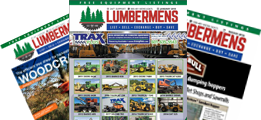Table of Contents Introduction: The Power of Planning in Equipment Maintenance What Is Included in a Forestry Machinery Maintenance Schedule? What Does a Forestry Machinery Maintenance Plan Include? What Is an Equipment Maintenance Plan? How Do You Make a Forestry Machinery Maintenance Chart? How Do You Start a Maintenance Report? Why Is It Important to […]
Used Sawmill Costs in 2025: Prices, Profit Potential and Guide
Table of Contents
- Introduction: Why People Are Turning to Used Sawmills
- How Much Does a Used Sawmill Cost in the U.S.?
- The Value of Owning a Sawmill
- Profit Potential of Small-Scale Sawmills
- How Much Does a Sawmill Charge for Cutting Lumber?
- Is a Sawmill the Same as a Lumber Mill?
- Conclusion: Making the Right Investment in a Used Sawmill
Key Takeaways
- Used sawmill costs can range from a few thousand dollars to $30,000+ depending on type and condition.
- Owning a sawmill can be highly cost-effective for landowners, woodworkers, and side hustlers.
- Sawmills can earn $50,000–$150,000+ annually, depending on scale and demand.
- Small sawmills are profitable when run efficiently with local sourcing and value-added services.
Sawmills and lumber mills are closely related, but not always the same in scale or function.
Introduction: Why People Are Turning to Used Sawmills
Let’s start with a simple truth: lumber prices have gone wild in recent years. From supply chain hiccups to inflation, the cost of wood has become a sore subject for builders, homesteaders, and hobbyists alike. But here’s the twist—more and more people are finding a clever workaround by investing in a used sawmill.
Now I know what you’re thinking: “Isn’t a sawmill some giant industrial machine for big companies?” Not anymore. The rise of portable and small-scale sawmills has opened up the playing field for individuals who want to take control of their wood supply.
Whether you’re building your own barn, starting a side hustle, or just want to mill lumber from your property, a used sawmill can be a game-changer—and surprisingly affordable.
So how much does a used sawmill cost? What’s the return on investment? Is it even worth owning one? You’re about to find out.
How Much Does a Used Sawmill Cost in the U.S.?
Let’s talk numbers—because used sawmill cost can vary wildly depending on the type, brand, and condition.
| Type of Sawmill | Price Range (USD) | Best For | Key Features |
| Manual Band Sawmill | $2000-$8000 | Hobbyists, small personal use | Basic operation, hand feed, minimal automation |
| Hydraulic/Portable Sawmill | $10,000-$25,000 | Semi-professional, frequent use | Hydraulic controls, power feed, increased productivity |
| High-End Industrial Sawmill | $30,000 + | Commercial/logging businesses | Diesel engine, computerized controls, full hydraulics |
| New Sawmills (for comparison) | $50,000 + | Large operations with higher capital | Brand-new with warranties and latest tech |
There’s a used sawmill for almost every budget. Just make sure to factor in transport, setup, and possible maintenance or upgrades when planning your purchase.
The Value of Owning a Sawmill
If you’re serious about saving money or turning wood into wealth.
Think about this—if you’re building a cabin, shed, or fencing system, buying lumber at retail could cost you thousands more than milling your own logs. A used sawmill pays for itself faster than you’d think.
Here’s where it gets even better: if you mill extra lumber and sell it locally, you’re not just saving money—you’re making it. Especially in rural areas or places with limited access to building supplies, you can quickly become a go-to source.
But it’s not just about money. Many sawmill owners love the satisfaction of working with raw timber, crafting what they need, and reducing waste. Owning a sawmill gives you creative and economic freedom.

Profit Potential of Small-Scale Sawmills
Absolutely—small sawmills are more than just backyard hobbies. They can be lean, mean, and highly profitable.
Here’s the key: efficiency and niche markets.
Small mills that offer custom cuts, furniture-grade slabs, or locally sourced rough-sawn lumber can command premium prices. Add kiln drying, planing, or even woodworking services, and your margins get even better.
Expenses are relatively low—especially if you start with a used sawmill, source your own logs, and do most of the work yourself. A few logs per week can turn into real income.
Local woodworkers, builders, and even homeowners are always looking for reliable, affordable alternatives to big box store lumber. That’s where your small mill shines.
How Much Does a Sawmill Charge for Cutting Lumber?
If you’re not ready to buy but still want lumber from your logs, hiring a sawmill might be your best option. But how much does it cost?
Sawmill pricing varies, but typical rates include:
- $0.35 to $0.75 per board foot (based on volume)
- $50 to $100 per hour (for custom on-site jobs)
- Flat day rates from $300 to $600+ depending on the mill and operator
Some mills charge setup fees or blade damage fees if you provide “dirty” logs with embedded nails or rocks.
Tip: if you’re planning to mill more than a few thousand board feet per year, it’s often cheaper in the long run to invest in your own used sawmill.

Is a Sawmill the Same as a Lumber Mill?
In most cases, a sawmill refers to the equipment or operation that cuts raw logs into usable boards. A lumber mill, on the other hand, might refer to a larger, more industrial facility that includes additional processing like kiln drying, planing, or finishing.
That said, in everyday use, they often mean the same thing. If you’re looking for a used sawmill, you’re essentially shopping for the equipment needed to turn logs into lumber—regardless of what it’s called.

Conclusion: Making the Right Investment in a Used Sawmill
So, is buying a used sawmill the right move for you?
If you’re looking to cut lumber costs, create new income, or get hands-on with your wood supply, the answer is likely a resounding yes. With affordable entry points, strong resale value, and multiple revenue opportunities, a used sawmill is more than a tool—it’s a gateway to self-reliance and entrepreneurship.
Whether you’re a homesteader, woodworker, or savvy investor, the used sawmill market is full of opportunity. Do your research, find the right machine, and start turning logs into profit.
Because at the end of the day, investing in a sawmill isn’t just about cutting wood—it’s about carving out a future.
FAQ’s
How much does a used sawmill cost in 2025?
Prices for used sawmills in 2025 typically range from $3,000 to $30,000+, depending on size, type, brand, and condition.
What affects the price of a used sawmill?
Key factors include age, hours of use, portability, cutting capacity, brand reputation, and available attachments or upgrades.
Where can I find used sawmills for sale near me?
You can find listings on platforms like Lumbermensco ,SawmillTrader, Craigslist, Facebook Marketplace, ForestryTrader, and through local dealers or auctions.
Is it cheaper to buy a used or new sawmill?
Used sawmills are significantly more affordable and can offer great value if well-maintained, though they may lack the warranty or features of new models.
Are small sawmills profitable for beginners?
Yes — many small sawmill owners make profits by cutting custom lumber, selling slabs, and offering milling services locally.
How much do sawmills charge for milling lumber?
Most sawmills charge between $0.35 to $1.00 per board foot, depending on species, cut type, and location.
What’s the return on investment for a used sawmill?
A used sawmill can pay for itself in 6 to 18 months, depending on usage, pricing strategy, and local demand for lumber or service

